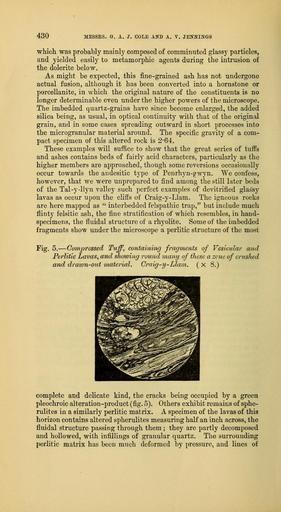MAKE A MEME
View Large Image

| View Original: | The_Quarterly_journal_of_the_Geological_Society_of_London_(13960444963).jpg (1154x2105) | |||
| Download: | Original | Medium | Small | Thumb |
| Courtesy of: | commons.wikimedia.org | More Like This | ||
| Keywords: The Quarterly journal of the Geological Society of London (13960444963).jpg 432 MESSES G A J COLE AXE A V JEXXIXGS <br> It is obvious from the first examination in the field that these <br> intrusive sheets which one may comprehensively class as diabases <br> have undergone considerable alteration Calcite is very freely <br> developed ; while quartz-veins are conspicuous in the large quarry <br> near Bron-y-Gader where they were formed prior to the infil- <br> tration or formation of the carbonate of lime In this quarry <br> Air Aildn observed epidote which he describes as fibres and <br> curved crystals of pale wine-yellow thallite While small epidotes <br> are certainly abundant the larger acicular crystals collected by <br> ourselves prove to be actinolite and tremolite ; and we have noticed <br> also greenish asbestos in the clefts on the northern face of Mynydd- <br> y-Gader <br> Under the microscope the original characters of these diabases <br> can be determined with some accuracy despite the wide develop- <br> ment of secondary products Thus the coarser varieties like the <br> rock of Bwlch-yr-hendref on the west and that of Bron-y-Gader <br> on the east were clearly dolerites approaching gabbro with <br> a well-developed ophitic structure The mass at Bron-y-Gader <br> contains stout porphyritic felspars and pale secondary horn- <br> blende The rock rising like a weathered dyke on the south <br> shore of the larger Crogenen Lake is particularly rich in plagio- <br> clastic felspar both as porphyritic crystals and as a well-marked <br> meshwork in the ground-mass granular altered pyroxene occurs <br> also interstitially in the midst of what probably was once residual <br> glass <br> The handsome rock of the north front of Alynydd-y-Gader is <br> again an ophitic dolerite of medium grain The pale brown augite <br> seems to have suffered little and the included felspars are also fairly <br> fresh While the structure of some of these rocks points towards <br> a basic composition we have failed to detect pseudomorphs after <br> olivine and believe that the iron originally separated out was even <br> smaller in amount than it appears at present <br> The characteristic decomposition-product of these basic rocks is <br> an epidote colourless in thin sections which occurs in every slide <br> associated with chloritic areas Its abundance coupled with that <br> of the all-pervading calcite implies an immense withdrawal of lime <br> from the original constituents In fact alumina and lime rather <br> than magnesia and iron must have been the prevailing bases during <br> these eruptions and the same evidence is afforded by the very tough <br> and compact greenstones either north or south of the old Towyn <br> Koad which are merely fine-grained variations of the types already <br> cited <br> On the whole these diabases contain surprisingly little secondary <br> quartz but in one instance that of a pale grey rock close under <br> the cliff of Tyrau Mawr this mineral occurs in the most striking <br> manner so that the mass at first suggests a porphyritic elvan The <br> microscope relegates this rock also to the andesites ; but the general <br> We use this term in the wide sense aud as an international equivalent of <br> the loosely-applied English greenstone 36940251 113696 51125 Page 430 Text 45 http //www biodiversitylibrary org/page/36940251 1889 Geological Society of London Biodiversity Heritage Library The Quarterly journal of the Geological Society of London v 45 1889 Geology Periodicals Smithsonian Libraries bhl page 36940251 dc identifier http //biodiversitylibrary org/page/36940251 smithsonian libraries Information field Flickr posted date ISOdate 2014-04-21 Check categories 2015 August 26 CC-BY-2 0 BioDivLibrary https //flickr com/photos/61021753 N02/13960444963 2015-08-26 05 54 14 cc-by-2 0 PD-old-70-1923 The Quarterly journal of the Geological Society of London 1889 Photos uploaded from Flickr by Fæ using a script | ||||